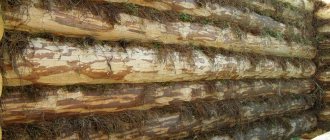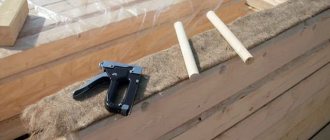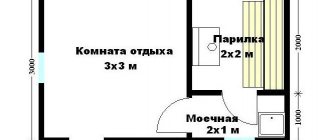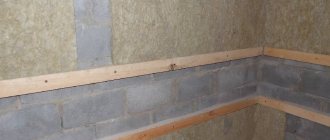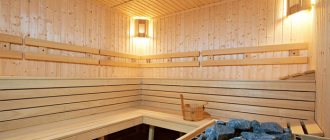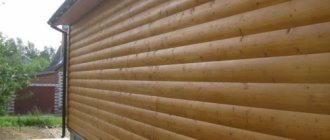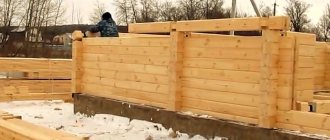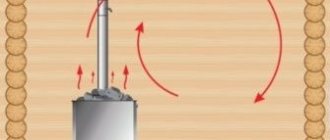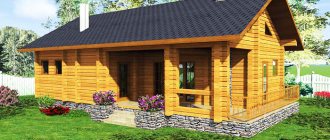Interventional insulation for log houses - choosing the best option
Traditionally, in the wooden construction of bathhouses or residential buildings, inter-crown insulation is used to seal the joints in the walls.
The main purpose of the material is to insulate the log structure and improve the performance characteristics of the wood.
Most insulation materials contain natural components, however, some materials may contain artificial filling, which is absolutely not suitable for wooden buildings.
- Why is insulation needed?
- Performance characteristics
- Types of inter-crown insulation Felt (sheep wool)
- Jute
- Moss
- Linen
- Tow
- Lnovatin
- Combined insulation materials
How to properly insulate a roof?
The question of whether it is necessary to insulate the roof of a bathhouse or not can only arise from an inexperienced owner. Experts know that high-quality insulation of this area will reduce heat loss by as much as 30%. Work is carried out along the perimeter of floors and slopes in the following order:
- At the first stage, the object is waterproofed - if this requirement was ignored during the construction of the building, a moisture-proof and vapor-proof membrane will still have to be laid over the rafters. True, now, for this it will be necessary to dismantle part of the roofing material.
- Next, all roof elements are treated with an antiseptic - if such a procedure has not been carried out previously.
- After preliminary preparation, the insulation itself is installed directly - slabs or rolls of balsat fiber have proven themselves exclusively on the positive side.
- The final stage involves internal covering of the laid material - even an ordinary vapor barrier film that is attached to the rafters will do; ideally, the structure is sheathed with clapboard.
Next to the roof, you can think about how to insulate a bathhouse made of timber from the outside.
Main requirements for insulation
- Uniform density and good elasticity. It should well close the seams between the beams not only during construction, but also after the building shrinks;
- Must have low thermal conductivity;
- The ability to absorb and release moisture like wood (this allows you to maintain the necessary moisture content of the wood and protect your house or bathhouse from dampness);
- Resistance to temperature changes and solar radiation;
- “Untasteful” in relation to insects and birds (taking away the “preparation” for nests);
- Durability and at the same time maintaining its performance qualities;
- No harmful substances to our health;
- Antiseptic properties that prevent biological damage by fungus and mold.
Both synthetic and natural materials can cope with the task of insulating a house. They have good thermal insulation characteristics. But we shouldn’t forget why many people build wooden houses. The main criterion for choosing this building material is its naturalness. So why ruin the whole eco-friendly picture of the house by using synthetic materials that can cause allergies in residents.
Synthetic insulation can be compared to plastic film; they do not allow air to pass through and prevent wood from breathing. A greenhouse effect occurs in the crown joints, which leads to the formation of mold, fungi and rotting of the wooden material. Therefore, you should not use them, even despite their good thermal insulation characteristics. After all, insulation materials should not harm the main building material.
Another thing is natural inter-crown insulation, we can say that they complement the characteristics of the logs being between their crowns. These materials have good thermal insulation, hygroscopicity, and vapor barrier. They do not interfere with the wood’s breathing and do not interfere with air exchange in the room. Many natural insulation materials have unique bactericidal properties, protecting the home from bacteria. They also contain a lignin component, which prevents the formation of biological agents in the inter-crown space.
Option for insulating a bathhouse complex from the outside
There are different ways to protect a building from the negative impact of the environment, but one of the most effective is considered to be a system of ventilated facades. This is an ideal solution for rooms with high humidity, because this design boasts not only excellent energy-saving functions, but also high vapor permeability.
Important! Any work on insulating a new bathhouse can only begin after the building has completely settled; this process takes on average no more than six months.
When preparing for work, first of all you need to take care of the insulation. Experts recommend using mineral fiber-based slabs in structures with ventilated facades.
Particular attention should be paid to the corners of the building, because it is through them that the most heat is lost - reduce the number of joints in this area as much as possible!
Do you want to know how to do everything strictly according to technology? See instructions:
- Prepare the walls - the process begins with a thorough cleaning of the surface, after which it is necessary to caulk the seams, and at the end treat the walls with an antiseptic. If rot is detected, the log is rehabilitated or replaced if the defect is severe.
- Install the brackets - they are installed on top of a layer of poranite or roofing felt.
- Install the sheathing panels on pre-prepared fasteners - they can be made from galvanized profiles or timber with antiseptic impregnation. The first option is less susceptible to deformation, but in cold weather it acts as a conductor of cold, so it would be more advisable to give preference to wood.
Advice: when assembling the frame, take into account the size of the insulation, and also take into account the required margin between the insulation layer and the edge of the wooden structure, it should be at least 2 cm!
- Place the insulation into the resulting cells - you can prevent the material from falling out with additional fixation with disc dowels.
- Cover the structure with a windproof superdiffusion membrane - only a vapor-permeable film is suitable, which does not allow moisture to accumulate under the skin.
- Finally, cladding is carried out with facing material.
Insulation for laying logs
Insulation of a log house occurs in two stages. The first is the laying of insulating material during the construction of a wooden house. And the second is caulking, which is filling all the remaining cracks and gaps with insulation - special tow for caulking. The choice of insulation for laying is very important; it must have excellent thermal insulation properties, good density and must be environmentally friendly.
Therefore, it is worth paying attention to natural insulation materials; they are created from plant fibers that nature itself produces. There are also artificial insulation materials, but they are not worth purchasing. They are made from synthetic materials and are no longer as safe and environmentally friendly. And their characteristics are much worse, although at the same time they retain heat well, but at the same time they cause significant harm to the logs.
Photo: this is an interventional gasket called Polytherm. This insulation is completely synthetic and should be used in the construction of wooden houses from laminated veneer lumber.
Among all the existing natural insulation materials for laying logs, the best are considered to be:
- Jute.
- Moss.
- Felt.
What is a log bathhouse made of?
At the moment, like hundreds of years ago, a Russian bathhouse is built from wooden beams. Constant technological growth could not leave this industry without innovative solutions. As a result, the conventional log house was replaced by more modern types:
- log house of profiled and glued timber;
- log house made of rounded logs.
With the introduction of new materials, the technological process of the procedure has also changed. Thus, a powerful log of a log house was insulated only between the crowns. While a rounded product requires a more scrupulous approach. Especially considering the fact that the bathhouse is used all year round. Regardless of the ambient temperature, a properly constructed structure should retain heat. The thermos effect is the ideal result of high-quality insulation.
To do all the work perfectly, you need to master the skills of a builder; you need, as it is now fashionable to say, “to be in the know.” The effectiveness of bath insulation procedures can largely be guaranteed during its construction. There are a lot of nuances: from the optimal thickness and height of the windows, to the correct location of the steam room relative to the dressing room and soap bar. Therefore, it is recommended to act correctly while developing the project.
How to insulate a log house
A log house is a constantly changing structure. The greatest changes occur in the first year after construction - the wall shrinks by about 8%. But in the future, uneven drying or periodic expansion of the wood leads to the formation of gaps between the logs, changes in the height and other dimensions of the wall. Such a structure must be insulated reliably, for a long time. How to do it?
How to remove cracks and eliminate air permeability
If there are through gaps in the wall, which is typical for a log house, then there is no point in talking about heat preservation in a wooden house. Air permeability should not exceed standard values. You can reduce it in two ways:
- Caulk the cracks. Sealing material is placed between the logs, both during construction and after cracks appear.
- By placing a continuous air barrier made of insulating material on the wall. We will consider how best to insulate further.
Materials for caulking a log house
To eliminate cracks in a wooden frame and seal the crowns, natural materials are usually used. They go well with wood and have been known to builders for a long time.
- Jute.
- Linen.
- Hemp (Industrial hemp).
What usually grows in areas where wooden houses are built is also not outdated:
- sphangum moss;
- cuckoo flax;
The shape of insulating sealing materials for a log house can vary as follows:
- Fibrous - for caulking cracks that appear over time.
- Tape - for laying between logs during construction.
How crowns are compacted, caulking
When building a log house, strips of sealant are laid on top of an already installed log along its entire length. Moreover, the width of the material should be such that it protrudes slightly on both sides of the log. Then the edges of the material are wrapped and hammered between the logs both outside and inside, thereby achieving better compaction of all irregularities.
During subsequent caulking, the fibrous material should be evenly distributed along the area intended for compaction. Local packing of a large amount of material can lead to distortion of the structure and the appearance of cracks in other places. A special tool is used - a caulk. The material is driven in on both sides of the wall.
Protection of log seams
But it is better to protect the natural sealant from atmospheric influences - rain, snow and wind. In addition, biodestruction is also affected - insects and birds. Now, to seal the sealing material from the outside, you can use modern compounds - special sealants for wood. It is important that they retain some elasticity for a long time, therefore they cover the cracks from through blowing and after movements characteristic of a log house.
We insulate the bathhouse from the outside
Insulating does not only mean protecting from blowing. Insulate - ensure conditions for maintaining a stable thermal regime indoors.
For log cabins or when building bathhouses in areas with mild winters, it is quite enough to carry out external insulation of the walls to protect the bathhouse from heat leaks. Inside there is only finishing made from natural materials.
At the same time, it is possible to insulate the walls from the outside immediately after the shrinkage of the log house, based on the thickness of its elements and the density of the crowns.
The attic is subject to external insulation:
- the ceiling is covered with glass hydrosol;
- it is filled with expanded clay, slag, or mineral mats are laid over the insulator;
- a reinforced or non-reinforced screed is made on top.
For external wall insulation, ventilated facade technology is used:
- a sheathing frame is created along the width of the sheets (mats, slabs) of insulation, exceeding the thickness of the sheets by 3 cm (for the ventilation gap);
- the insulation is laid in the sheathing structure from bottom to top:
- the diffuse membrane is attached to the sheathing with a stapler;
- Facades are faced with varnished lumber, false beams or colored siding.
Insulation for a log bathhouse or for timber
For a log, a thicker layer of insulation (especially strip material) is taken, and for a bathhouse made of timber, a thickness of 8-10 mm is sufficient. If you use laminated veneer lumber, you can get by with a thickness of 5 mm. IMPORTANT! If there are gaps or other irregularities in the timber, the insulation is placed in two layers.
Materials based on plant fibers are perfect for logs, and roll products are ideal for timber.
It is advisable to complete the insulation of a bathhouse made of timber with finishing materials: clapboard, siding or block house. We recommend treating wooden finishing materials with special impregnations or oils.
It should be remembered that depending on the material from which the bathhouse is built, there are nuances of thermal insulation and recommendations regarding the materials used: insulation of walls made of wood, brick, blocks (especially foam concrete), frame walls requires special attention.
Useful video
Look at another professional’s opinion on the issue of “moss or jute”:
Materials suitable for baths
A bathhouse is a place where all structural elements constantly endure temperature changes and their contrasts. In conditions of moist heat, the evaporation of many synthetic substances and polymers is activated; tactile contact with heated building materials can result in burns.
These operational features determine the mandatory technical characteristics of materials used for insulating baths: thermal conductivity, moisture resistance, fire safety, natural components, environmental friendliness.
In order for the bathhouse to become a place for improving health, it is preferable to assemble a log house from wood from Siberian forests (cedar, larch, pine), harvested in winter. For cladding premises, hardwoods are chosen that do not release resins and essential oils when heated.
Since ancient times, popular insulation materials have been organic and natural: clay, peat, expanded clay, flax fiber, moss, jute, tow.
Waterproofing agents are often bitumen mastic, glass hydrosol, euroroofing felt (except for use in steam rooms), and polyethylene film with a density of 140 microns.
The optimal types of vapor barriers for bathhouses are kraft paper, aluminum foil, and at the same time insulation - foil penotherm (NPP polypropylene laminated with foil).
And this article tells you how to make a picket fence from corrugated board.
Log house
In fact, there is no point in insulating a log bathhouse, since wood itself is an excellent heat insulator.
In addition, due to additional insulation, the area of the bathhouse is reduced.
Thus, if you are still hesitant about insulating a log bath, then you should know the following facts about the thermal insulation characteristics of a log house, depending on its diameter:
- More than 20 cm – there is no need for additional insulation;
- 15 cm – thermal insulation is not necessary, but heating the room will take a long time;
- 10 cm – thermal insulation of the room is necessary.
Types of interventional insulation
The modern construction market offers a large selection of natural insulation materials.
The most common options are felt, jute, moss, linen and combined.
Manufacturers also offer wear-resistant synthetic insulating materials - penofol, mineral wool, polystyrene foam boards, silicone sealants.
Without a doubt, they have higher performance characteristics in comparison with natural analogues, but they are not suitable for insulating wooden buildings.
The main thermal insulators used: pros and cons
The origin of the word “caulk” is associated with hemp, from which hemp and twine for sealing cracks were made hundreds of years ago. Products based on this plant are still produced in separate nonwoven fabric factories. But sphagnum moss and “cuckoo flax”, which were once the most popular sealants in Russian wooden architecture, are now perceived as exotic. We will limit ourselves to considering what is present on the shelves of construction supermarkets and specialty stores.
Rolled flax insulation
Inter-crown linen seal
This inter-crown insulation is made from flax fibers using needle-punched technology. We can order any strip width from 3 to 40 cm in 0.5 cm increments. The thickness at a density of 700 g/m² is 8 - 10 mm.
Additional insulation
additional insulation . To preserve heat, it is preferable to make them small and at the bottom of the wall. The most reliable are triple-glazed windows, provided they are tightly inserted into the wall openings and seal the cracks.
High thresholds and small door frames with a low ceiling will also help preserve heat in the room. The entrance from the dressing room to the soap room and steam room should not be located on the same axis.
The dressing room should have a door insulated with thick felt and vinyl covering. The insulation should be 10 cm larger than the dimensions of the door. It’s even better if the entrance to the dressing room is equipped with a closed vestibule.
When modernizing an old or building a new bath complex, it is extremely important to provide the building with an effective thermal insulation system. At all times, people knew that completely sealing a bathhouse provides an excellent microclimate in the room with little energy consumption. In addition, in Ancient Rus', the bathhouse often performed utilitarian functions. Now, when every home of a modern person is equipped with once innovative plumbing equipment, going to a Russian bathhouse has become an ancient folk tradition.
The steam room is always popular as a leisure activity, because in addition to the undeniable health effect, there is a pronounced entertainment factor, since the bathhouse is associated exclusively with relaxation. Although today such a structure can be built from a variety of materials, natural resources are still popular. You can find out how to insulate a wooden bathhouse from the inside and outside in this publication. First things first...
Reviews and tips
Insulation of a log house is an urgent need. The gaps between the crowns of a log house can negate any heating! How to get rid of drafts in a log house? Several solutions have come to us from time immemorial. The new century offers new methods.
Forest moss in the log cabins of the past
Sphagnum moss and polytrichum (otherwise known as cuckoo flax) are common plants in damp, marshy areas. Dried moss shoots are elastic, fibrous and spongy; They have long been used as a spacer between the crowns of a log house.
Compressed with beams or logs, the moss adheres tightly to the wood surface and closes the gaps. Moss shoots contain phenol, a compound that is harmful to microorganisms. The moss that fills the cracks of the log house does not rot itself and prevents the wood from rotting.
Disadvantages of moss as inter-crown insulation
As insulation for a log house, moss is not free from drawbacks. The high hygroscopicity of sphagnum does not play a big role in dry weather, but in rain it can become a problem, and in winter it can even cause freezing of the inter-crown spaces. Overdried cuckoo flax fibers become brittle and fragile. The availability of moss does not negate the complexity of its collection, processing and use.
Adherents of authentic log construction collect moss by hand - quickly and in large quantities. Experts mostly reject indiscriminately collected material: for inter-crown insulation, plants with shoots of maximum length should be taken: 20 cm for sphagnum, 45 - 50 cm for cuckoo flax. It is impossible to collect more than two bags of such moss per day, while one log house requires several dozen bags of dried moss.
To prepare, the moss is washed, soaked in warm water up to 40°C for several hours, and then dried, preventing the material from drying out.
The moss is laid out on the crown in an excess, loose, wide and thick layer without any attachment to the wood. In this case, uniform compaction is not achieved, so the gaps between the beams or logs must subsequently be caulked - and repeatedly!
The ability of moss - especially sphagnum - to absorb water becomes evil when the wall of a log house gets hit by slanting rain. Even dry and compressed shoots of moss perfectly transport moisture from the outside to the inside, and then real streams flow along the wall of the house.
Insulating a wooden bath from the inside
How to insulate a bathhouse made of logs (timber)? You should start with insulating the ceiling , it is the one that takes on the first wave of heat and steam. The heat-insulating layer must be significant (in the steam room - up to 15 cm) with a mandatory vapor barrier membrane: for the steam room - this is foil, for other rooms - kraft paper or thick polyethylene. It is also enough to cover the walls in the soap room and dressing room from the inside with clapboard or wooden blocks made of hardwood (aspen, linden).
- Ceiling insulation algorithm:
- We overlap the surface of the wooden ceiling with clean rolled paper (secure it with tape and a stapler);
- we attach bars across the ceiling that exceed the thickness of the insulation used (preferably rigid mats made of basalt wool or slag fiber); for the ceilings of the dressing room and soap box, expanded clay, sand and even sawdust mixed with clay can be used as insulation;
- the mats are laid out in the crate;
- the next layer is aluminum foil, the joints of which are taped;
- the sheathing is attached to the foil as a basis for the front cladding;
- if the ceiling of the bathhouse will be used as the floor of another room, then 3 cm of cement-sand screed under the wooden flooring is placed on top of the insulating layer.
- Algorithm for insulating walls in a wooden bathhouse (for a steam room):
- work is carried out from above, from the ceiling;
- start with biocidal impregnation;
- cracks are sealed with sealant or plaster;
- Magnesite boards and gypsum fiber are used as a heat insulator;
- a vapor barrier (foil) is stretched horizontally along the walls, covering the ceiling (attached to the wall, joints are sealed); it is possible to use a new, high-temperature resistant material - foil foam;
- on top of the resulting layer, sheathing made of hardwood with a low density coefficient is attached to vertically located bars;
- A gap of 2 cm is left between the cladding and the vapor barrier to create a ventilation space and prevent the formation of condensation.
Algorithm for floor insulation using a basic screed:
- a layer of 15 cm of mineral wool is laid;
- covered with euroroofing felt extending to the level of the plinth;
- logs are treated with an antiseptic;
- subfloor is laid;
- finished wooden floor made of tongue and groove boards.
And here is an article about insulating the ceiling in a bathhouse on your own.
Carrying out work to seal inter-crown gaps
It is better to entrust the sealing of inter-crown gaps to specialists with skills and experience in such work. For caulking, a mallet (a wooden hammer) and a caulking tool, a tool made of metal or hardwood, are used.
To seal the inter-crown cracks, caulk is used. In this case - metal.
Skilled workers have a whole range of caulking tools. More often they use a typesetting spatula - a flat spatula with a blade at the end 100 mm wide and 5 mm thick. To carry out work in corners and rounded places, you need a curved caulk with a blade 50-60 mm wide. When it is necessary to slightly widen tight grooves, use a split caulk equipped with a wedge-shaped blade 30 mm wide. This tool makes it easier to insert tow into narrow grooves.
And finally, another variety - a road worker with a blade up to 170 mm wide and 8 to 15 mm thick, along the length of which there is a groove up to 10 mm deep. It is used to plant strands of tow and give it the shape of a roller.
The conversation about inter-crown insulation is quite long, and within the framework of one article it is impossible to talk about all types of materials used today. Therefore, in one of the following articles we will return to this topic.
These articles may also be of interest to you:
- Construction of a house from laminated wood panels
- Caulking and insulation of the log house. Materials and technology
- We build an insulated house from timber
- Replacing the siphon and sink drain
How to choose inter-crown insulation for timber: what types are there and what to pay attention to when laying
Despite the constantly growing range of modern building materials, no one is in a hurry to abandon the use of natural wood for the construction of houses. You can even probably even notice the opposite trend - the popularity of wooden construction is only growing, apparently because there is something to compare with, and these comparisons only play into the hands of the natural material. Indeed, if we evaluate the totality of qualities - accessibility, low thermal conductivity, ease of processing, absolute environmental friendliness, the ability to create a completely unique healthy atmosphere in the house - not a single innovative material can compare with wood.
Interventional insulation for timber: which one to choose?
Of course, wood also has its drawbacks, and some of the main ones can be considered the lack of plasticity and the tendency to deform when external conditions change. No matter how precisely the parts for the construction of log or timber walls are adjusted, it is still impossible to achieve a complete absence of gaps between them. This means that it will be necessary to provide a seal between the elements of the log house. For these purposes, a special material is used - inter-crown insulation for timber - this publication will tell you which one to choose.
Expert opinion: Afanasyev E.V.
Chief editor of the Stroyday.ru project. Engineer.
Even if the future owner of the house does not have carpentry skills and is going to involve a team of specialists in the construction of the log house, it will never be a bad idea to supervise their work. Unfortunately, there are often “schemers” who, trying to extract the maximum benefit and speed up the work, resort to all sorts of unscrupulous “tricks”, the consequence of which can be poor insulation and ventilation of the walls. This is often discovered only after some time, with the onset of cold weather, and often correcting such defects even requires a complete overhaul. It is better to keep this under constant control.
What is the main point of using interventional insulation?
Before moving on to considering the types of inter-crown insulation, it is necessary to briefly discuss its purpose - this will make it easier to subsequently make the right informed choice.
- The use of such material significantly enhances the natural thermal insulation qualities of wood. The cold does not penetrate through the joints deep into the log walls, the wood freezes less on the outside, and this means a reduction in the number of cracks that appear, and, by and large, an overall increase in the entire service life of a wooden house.
Poor quality insulation of joints between logs or beams leads to deeper freezing of the walls and the rapid appearance of extensive cracks
- High-quality inter-crown insulation compensates for fluctuations in the volume of wood when it dries out or, conversely, swells from high air humidity.
- Properly installed insulation prevents water or excess moisture from entering the gaps between the beams, which can activate wood rotting processes or become a favorable environment for the development of foci of fungus or mold.
A very sad picture - the log house is infected with a fungus precisely at the joints between the beams
- Properly selected inter-crown insulation will become a barrier against insects entering the house.
- The compacted joints between the beams not only prevent the room from being blown out and cooled down, but at the same time the level of noise penetrating from outside is sharply reduced.
- High-quality inter-crown insulation does not disturb the normal balance of humidity and temperature in any weather conditions - the most important advantage of wood is preserved - the ability of walls to “breathe”
So, the importance of this material for the construction of a high-quality and durable log house is difficult to overestimate. It remains to find out what types of interventional insulation exist, and what advantages and disadvantages they have.
Types of interventional insulation and their specific features
It would be a big mistake to believe that any available material will be suitable for insulating roof joints. It happens that the low price of some thermal insulation materials provokes buyers into an ill-considered purchase, for example, mineral wool, but the result is sad.
Special operating conditions require inter-crown insulation and corresponding characteristics - low thermal conductivity, mandatory elasticity and the ability to restore volumetric shapes after compression, durability, strength of the fiber structure to fractures, resistance to biological decomposition, to exposure to the sun, high and low temperatures, and at the same time preserved its naturalness, remaining completely “clean” and harmless from an environmental point of view.
Interventional insulation under conditions of strong compression between beams or logs should not cake, lose elasticity and thermal insulation qualities
It is quite difficult to select a material that would fully meet all the stated requirements. Nevertheless, a number of natural or synthetic insulation materials are very close to perfection, which is why they are widely used specifically for wooden construction.
Natural interventional insulation
The history of wooden architecture goes back centuries, and people have always faced the problem of insulating their homes. Naturally, a variety of natural materials that were available were used. Gradually, a kind of “selection” took place - materials that did not live up to expectations went out of use, and those that proved their worth are still actively used to this day.
Moss is a material for insulating log houses
Residents of the wooded and taiga middle and northern zones, where there are usually many wetlands, have long used moss to insulate their houses. Interestingly, this accessible natural material not only protected houses from blowing, but also ensured long-term preservation of the wood. Incredible, but true - even after many decades of operation, the log houses remained intact, and they could easily be dismantled and used for construction in a new place.
The traditional material for inter-crown insulation is moss
It's all about the natural qualities of some mosses - their biochemical composition includes a large amount of phenolic acids, which, as is known, are powerful antiseptics that easily deal with most putrefactive and other pathogenic bacteria. Naturally, contact with such insulation provided the logs with additional resistance to biological decomposition.
Mosses are actively used in construction today. They have long justified their qualities, and what is especially attractive is that the material is practically free, except for your own labor costs for procuring raw materials.
Jute inter-crown insulation
Of course, working with moss insulation is more difficult than working with ready-made tape materials. But in some cases their use becomes even more effective. This is especially true for buildings erected from hand-processed logs or non-profiled timber. In such conditions, it will be more convenient to regulate the thickness of the layers with this material in order to fill the gaps between the rims as densely as possible.
Besides, probably none. No other insulation material can compare with moss in terms of the atmosphere created in the premises of a wooden house. It is characterized by a unique forest aroma, saturated, among other things, with medicinal components that can have a healing effect for people with chronic diseases of the respiratory system and skin.
Of course, not all mosses from the variety available in our nature are suitable for such purposes. Only two types are used as inter-crown insulation - sphagnum and “cuckoo flax”.
- Sphagnum is probably familiar to all those who have ever been to a peat bog. Typically, thickets of this moss cover a swampy area of the forest with a dense, extremely thick green carpet.
A forest swamp overgrown with sphagnum moss.
Collecting such moss is not difficult - it gives in quite easily, coming off together with the root part in thick bunches.
A torn bunch of sphagnum
It is recommended to go for sphagnum moss in good, clear weather so that the collected moss is as dry as possible on top. The fact is that sphagnum is not used immediately - it requires some drying in heaps under a canopy, from one to two weeks. And the drier the material was when collected, the shorter the preparatory period will be.
Dried sphagnum is ready for insulation work
There is no need to be afraid that after drying, the stems and leaves will become brittle - that is the advantage of such moss, that when it dries. Unlike, for example, grass, it does not lose its qualities, remaining dense, elastic and maintaining the porous structure of the mass, which determines high thermal insulation properties.
Laying sphagnum during the construction of a log house
Laying dry sphagnum on the crowns is quite a troublesome task, requiring a certain skill - it is necessary to achieve a uniform and complete fit of logs or beams along the entire length. But the wood will receive highly effective natural protection. The antiseptic properties of mosses are expressed to the maximum extent in sphagnum. It is not without reason that it has been used since ancient times as a healing agent in folk medicine, in military field surgery, in veterinary medicine, etc.
Video: how sphagnum moss is harvested for insulating a log house
- “Cuckoo flax” actually has nothing to do with either real flax or cuckoos. The name apparently comes from some similarity in the fibrous structure and small leaves. And the silhouette of a cuckoo resembles a box that forms at the top of the stem of a plant.
Thickets of “cuckoo flax”
This moss also grows in vast clearings in peat bogs, and it can be collected quickly in large quantities. It is recommended to look for forest “plantations” - there the “cuckoo flax” will not be so saturated with water. The length of the stems protruding above the surface is usually 150 -200 mm, but it happens that they reach a height of even 400 mm or more.
Sacks with collected “cuckoo flax”.
For its collection, cloudy, cool weather is already recommended - it is believed that under such conditions it retains its qualities better. The collected moss is laid in long strips for easy drying, but you should not be overzealous - overdried stems can become somewhat brittle, and you will even have to moisten them before laying. By the way, such insulation is often placed on the crowns even immediately after collection. No additional drying.
Intercrown insulation
Laying out the insulation on the crown logs
The layout is carried out layer by layer, alternating the direction of the fibers. After the construction of the log house is completed, the protruding fringe is caulked into the joints between the beams.
During the operation of the house, high-quality insulation should not cause any problems - it does not age inside the joint, does not crumble, and maintains the moisture balance in the wood well. The disadvantage is that “cuckoo flax” is readily consumed by many birds, trying to dig it out of the cracks. Very careful caulking is required, or even better, covering the insulated joints with jute rope. In addition, the external caulking will still have to be renewed from time to time - the fibers protruding outwards gradually become brittle and fly off.
Linen-based inter-crown insulation
One of the crops traditionally grown in our area for a long time is flax. After processing the collected raw materials, thin fibers became material for making fabrics, while coarse and short fibers were used as tow. And the direct purpose of tow has always been – caulking cracks.
This is what ordinary flax tow looks like
Tow, in principle, is a very good heat insulator and sealant, but working with it during the construction of a log house is just as difficult as working with mosses. It is quite difficult to lay out this material in the required layer, with approximately the same density, achieving complete filling of the cracks and gaps. In addition, this inconvenience can be further aggravated by windy weather. Another disadvantage of tow is that birds love to use its fibers to build their nests.
It is much more convenient to use a special linen-based material for inter-crown insulation. It is often called flax wool or linen felt. And for its production, it is no longer sorted flax waste that is used, but high-quality raw materials. As a result of special processing using pressing, a non-woven fabric with a thickness of 5 to 8 mm is obtained, which is cut into strips of various widths (from 8 to 200 mm) and sold in rolls up to 20 meters long.
Rolls of flax wool are very convenient when building a log house
The width of the rolls is selected depending on the size of the timber or the profile grooves on it, intended specifically for laying tape inter-crown insulation. If necessary, for a tight fit of the crowns, laying in two or even more layers is practiced - depending on the geometry of the beam or log. The installation itself is not difficult - the insulation tape is attached to the tree using staplers, that is, windy weather will not interfere.
The insulation strip is secured to the beam with staplers
Usually, when laying such insulation on timber without special profiling or on a log, they try to avoid letting it hang over the sides of the wall being built. It is better to bend its edges when laying it inside - this way you can avoid the tedious procedure of subsequent caulking.
Some techniques for installing tape insulation between beams and crown logs
advantages of flax wadding tape insulation:
- It provides a uniform, reliable seal along the entire length and width of the wall part being installed.
- The cracks become windproof, which ensures a high level of thermal and noise insulation.
- The material is stable - it will not crumble, crumble, etc. over time.
- The material has good vapor permeability, and in addition, it contributes to a normal humidity balance - either by absorbing excess moisture from the air or releasing it back into the atmosphere.
- Flax wool is absolutely harmless even for asthmatics and people prone to allergic reactions.
- Ease of installation has already been mentioned.
Disadvantages of the material:
- Flax wool is not sufficiently protected from biological damage - debate or rotting. In addition, very harmful insects can make nests in it - bedbugs, moths, grinders and others. Therefore, the issue of antiseptic treatment of wooden parts is of particular relevance.
- Flax fibers in any form are taken by birds to build nests. Very careful caulking is required, or even better, sealing all joints with jute ropes.
Unprotected caulked joints are a real “godsend” for birds. The best option is to close it with jute ropes.
Jute interventional insulation
An excellent insulation material for crowns is jute and materials based on it.
Dut is obtained by processing an annual tall plant (a distant “relative” of our linden) of the same name - it is very widely cultivated in regions with a tropical climate. As a result of processing, long and strong fibers are obtained, which are very widely used.
Jute collection, its primary processing and drying, and the resulting fibrous structure
A distinctive feature of jute fibers is their high concentration of lignin, a natural resin with pronounced antiseptic qualities. The material practically does not rot under the influence of moisture, does not lose its strength - it is not for nothing that jute ropes have always been famous in shipbuilding. Jute is completely unattractive to birds, insects, and rodents - also an obvious plus.
The material is able to “share” its antiseptic qualities with the wood in contact with it - logs or beams of a log house receive additional protection.
However, a high resin content also has a “downside” - this leads to gradual gluing of fibers together, loss of ductility - jute can become coarser and stiff over time. To eliminate this drawback, but fully preserve the advantages of the material, in the production of inter-crown insulation, it is usually combined with flax fibers. Various options are possible here.
- Linen jute is a layer-by-layer arrangement of flax and jute fibers, in an approximately equal overall ratio of 1:1. The resulting material retains the elasticity inherent in flax, but the strength of jute is not lost. A layer of flax fibers is located inside the material, and jute creates a reliable, stable “shell” on the outside.
Roll of flax-jute felt inter-crown insulation
- When making jute felt, the flax content usually does not exceed 10%, but the fibers are mixed during the production stage. The linen component smoothes out the rigidity of the jute component, prevents the fibers from sticking together, and the overall strength and pronounced antiseptic qualities are not lost at all.
In addition, ropes (ropes) are made from pure jute, which are also widely used for inter-crown insulation - for the final external caulking of joints.
The installation of jute inter-crown insulation is, in principle, no different from the above-mentioned use of linen materials. The only difference is that jute, as already mentioned, is not taken away by birds, and its natural color harmonizes well with the shades of wood, that is, a slightly protruding layer of caulking or jute rope hammered along the joints will only give the log house a special neatness.
polyester insulation
Insulation based on natural wool
It is quite natural that in regions where livestock farming was traditionally at a high level of development, wool waste was used to insulate housing. This is still practiced in our time.
Natural wool felt fabric
Wool fibers are specially processed to prevent them from being damaged by insects, and are tumbled using a special technology into felt sheets of varying densities and thicknesses - from 10 to 20 mm. Then they are cut into strips with a width of 80 to 200 mm - and in this form the insulation goes on sale.
Wool insulation on log beams
This inter-crown insulation has many advantages:
- The quality of thermal insulation and noise absorption is the highest.
- Wool does not mat over time, does not lose elasticity, and perfectly fills all voids, leaving no chance for “cold bridges.” If the wood is deformed in one direction or another, the elasticity of the felt will prevent cracks from appearing - the tightness of the fit will be maintained.
- Well-processed wool is not afraid of moisture and will not rot, while helping to maintain an optimal moisture balance.
The only drawback is, perhaps, the high price of such insulation materials, which, in principle, predetermines their less widespread use compared to materials of plant origin.
Synthetic inter-crown insulation
In addition to natural insulation, artificial, polymer-based insulation has recently begun to be used more and more widely. For many, this approach raises certain concerns due to the unnaturalness of the material, but manufacturers convince that their products are fully adapted to wooden construction, are completely harmless, and sometimes even surpass natural materials in performance.
As an example, we can cite several varieties of such inter-crown insulation.
"PolyTerm"
This is a development of Finnish technologists, that is, carried out “with skill,” since wooden construction in Finland with its harsh winters is extremely widespread.
Rolls "PolyTerm" of various widths
“PolyTherm” is produced on the basis of polyester fibers, which are completely harmless to humans and nature. The material does not decompose over time, completely retaining its chemical formula, that is, there is no need to fear the release of any toxic substances.
- The insulating qualities of the material are very high. And elasticity and elasticity, which are not lost throughout the entire service life, ensure complete filling of all voids and gaps both during the construction process and during the entry of deformation vibrations of the log house.
- Despite its synthetic origin, PolyTerm has excellent vapor permeability, that is, it will not disturb the normal moisture balance of air and wood. At the same time, it has pronounced hygroscopicity and does not absorb water like a sponge. When using it, you can do without additional external caulking.
- The material is completely uninteresting to birds and will not become a breeding ground for microflora or insects.
- An important advantage is that the material is non-flammable.
- The chemical resistance of polyester fibers is a guarantee of the absence of allergic manifestations, even in people with a tendency to them.
Particularly convenient when constructing a log house are special shaped elements for joints of logs or beams.
The service life of such inter-crown insulation, according to the manufacturer, is practically unlimited.
"AVATERM"
It's nice to know that domestic manufacturers are also capable of producing products of the highest quality. An example of this is inter-crown insulation of the “AVATERM” brand, produced by the company of the same name from St. Petersburg.
Russian logo
This material, also on a polyester basis, was developed taking into account all available modern technologies, and special attention was paid to adapting the insulation specifically to Russian climatic operating conditions.
"AVATERM" has all the same advantages as "PolyTerm", and at the same time the manufacturer boldly declares that the service life of the material can reach 200 years.
The product range corresponds to common types of profiled timber - the process of laying insulation into the grooves of the parts becomes extremely simple. There are special varieties for logs, for regular, profiled and separately laminated veneer lumber, taking into account the characteristics of these building materials.
The convenience of such insulation when assembling a log house is also due to the fact that when drilling holes for dowels, the material does not wrap around the drill - it easily passes through it, leaving smooth edges.
Factory packaging of AVATERM insulation
The thickness of the produced tapes is 8, 15 and 20 mm, the width is from 100 to 200 mm, the length in rolls, depending on the thickness, is 10 or 20 m.
Of course, many will be pleased with the affordability of the material - this can significantly reduce the overall cost of building a house.
Plastic sealants for sealing joints
It should be noted right away that such sealants, by their nature, in principle, are not full-fledged inter-crown insulation and in no case replace the use of the above-mentioned materials when building a house. Their purpose is to seal the remaining or emerging seams between beams or logs or to protect the protruding edge of the caulk from external influences. They are also widely used for repairs - filling deep and wide cracks formed on wooden parts.
Sealants are used to fill remaining or emerging cracks and cracks, to completely seal seams
Very often they are used in combination with an elastic band, for example, of foamed polyethylene, which is first hammered into the gap and sealed on top with a sealant.
Combination of polyethylene foam rope hammered into the gap and sealant
There are many varieties of sealants for this purpose. They can be acrylic (more suitable for interior work), silicone, latex or polyurethane based. It is often possible to select the shade of the sealant so that the seam lines look harmonious against the exterior of the wooden frame.
Seams between logs after treating them with sealant
Popular brands of such sealants include “NEOMID - Warm Seam”, “Wepost Wood”, “Conseal”, and a wide range of “Weatherall” products for a variety of cases. Before purchasing, you should definitely pay attention to the scope and specific purpose of the material - there may be significant differences in this matter.
Video: Sealant for log house “NEOMID - Warm seam”
So, the main types of inter-crown insulation were considered. Each of them has its own “bouquet” of advantages and disadvantages. The choice is up to the owners of the house, and it must be made consciously, taking into account both the future conditions of use of the housing and from the point of view of purely economic feasibility.
At the end of the publication - another video dedicated to inter-crown insulation:
